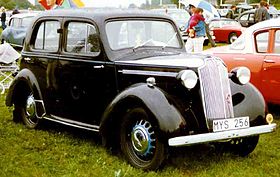Vauxhall 10-4
| Vauxhall Ten | |
|---|---|

1938 Vauxhall Ten 4-Door Saloon
|
|
| Overview | |
| Manufacturer | Vauxhall (General Motors) |
| Also called | Vauxhall Wyvern (Australia) |
| Production | 1937–1940 1946–1947 |
| Assembly | Luton, England |
| Body and chassis | |
| Class | Small family car (C) |
| Body style | 4-door saloon 2-door coupe 2-door tourer (Australia) 2-door roadster (Australia) |
| Layout | Front-engine, rear-wheel-drive |
| Powertrain | |
| Engine | 1203 cc I4 ohv 34 bhp (25.4 kW) (1937–1940) 1203 cc I4 ohv 31.5 bhp (23.5 kW) (1946–1947) |
| Dimensions | |
| Wheelbase | 94 in (2,388 mm) (1937–1940) 97.75 in (2,483 mm) (1946–1947) |
| Length | 155.5 in (3,950 mm) (1937–1940) 159 in (4,039 mm) (1946–1947) |
| Width | 61 in (1,549 mm) |
| Curb weight | 2,016 lb (914 kg) |
The Vauxhall 10-4 is a British-built small family car produced by Vauxhall between 1937 and 1947. It was launched at the 1937 London Motor Show and was the first British car to have a unitary construction body.
A structural innovation, following the pattern set in 1935 by GM's German subsidiary, was the Ten's integral (chassisless) construction. According to Maurice Platt, who transferred from technical journalism to a career with Vauxhall in 1937 (and would be employed as the company's Chief Engineer between 1953 and 1963), the Vauxhall Ten became known within the company as the million-pound car, which reflected the extent of the company's investment in tooling up for the new model. Unfortunately war intervened, however: Vauxhall’s Luton plant switched to tank production and the Vauxhall 10 was unavailable after 1940.
The model was re-introduced in 1946 with the same 1203 cc ohv engine as before, albeit with a reduction in claimed power output. The post war Vauxhall 10 was little changed in other respects. However, with British consumers cash-strapped, and the market for small family cars of prewar design closely contested, Vauxhall withdrew their 10 in 1947. From then until the introduction of the Vauxhall Viva in 1963, the company concentrated on larger and presumably more lucrative models.
The name of the car referred to its fiscal horsepower, which at this time defined the class in which it was to compete against cars such as the Morris 10, the Standard Ten and the Ford 10. The Vauxhall 10’s advertised horsepower in 1937 was 34 bhp (25 kW).
...
Wikipedia
